Two camps emerged in the March meeting as the Art Commission debated the proposed artwork for the Rail Park (Phase 1 opening Fall 2018). Poet Laynie Browne and artist Brent Wahl presented a collaborative work of public art meant to be discovered by people walking on the elevated park. But Commissioners’ suggestions focused on simplifying the work to make it a better landmark.
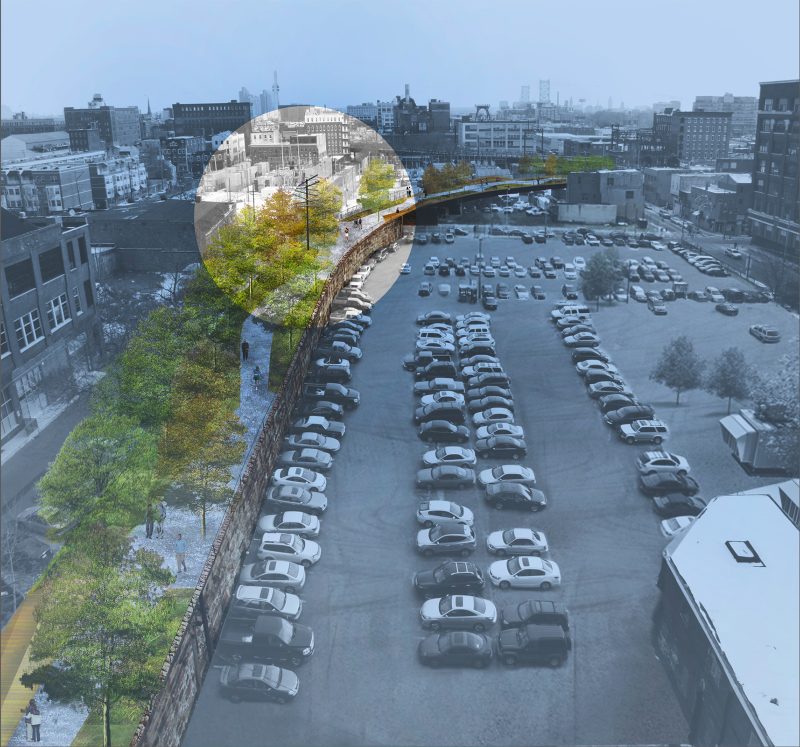
Speaking to the past
The proposed artwork is entitled “Dawn Chorus,” a 35-foot tall wooden telephone pole, with 7 aluminum cross beams holding cast bird forms in red, orange, yellow, green… all the colors in the visible spectrum. Leading up to the sculpture, says poet Browne, will be a “constellation” of selected poems around the theme of “communication in a multi-lingual meeting place.” These poems will be engraved into the granite pavers in the Park’s walkway (like the pavers at the Kelly Writer’s House, pictured below) in the poet’s original languages of English, Spanish, German, Russian, and will appear more frequently as a viewer approaches the sculpture. The Commissioners also suggested some of the poems be in Chinese, to recognize the adjacent neighborhood of Chinatown.
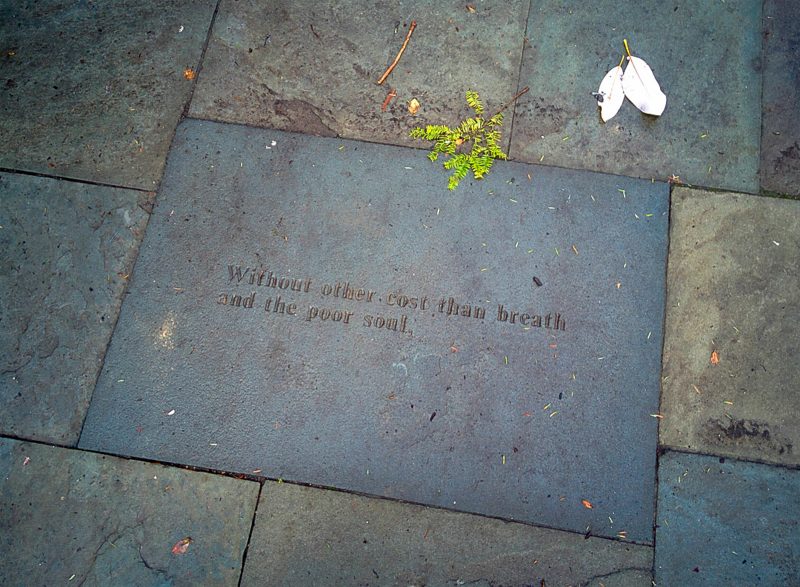
“Dawn Chorus” takes its inspiration from the post-industrial landscape of the surrounding Callowhill neighborhood, and the history of the nearby rail station at Broad and Callowhill Streets. In its heyday, the Philadelphia and Reading Railroad station was a hub of communication, and a meeting place for many cultures. Like with the network of railroad tracks crisscrossing the nation, the network of telegram and telephone utility poles allowed for transmissions to be sent across the country. The sculpture is a direct homage to this history, and the poetry expands on those ideas.
Artwork or landmark?
Although the piece received Conceptual Approval, the Art Commission’s response was tepid. Commissioner Robert Roesch took particular interest in the cast birds. He asked about the size and shape, and wondered if, at the proposed size, they would be legible from the ground. Other commissioners wanted more clarity on the size and quantity of the crossbeams, and wondered if the sculpture would clear the surrounding trees (they would, confirmed architect Bryan Haynes). Commissioner Joe Laragione mused that he wasn’t sure that the piece would read as a sculpture.
“If it’s going to be an icon you can see from the street, you don’t want to look at it and see a confluence of chaos… it’s got to have something we can read right away,” said Roesch.
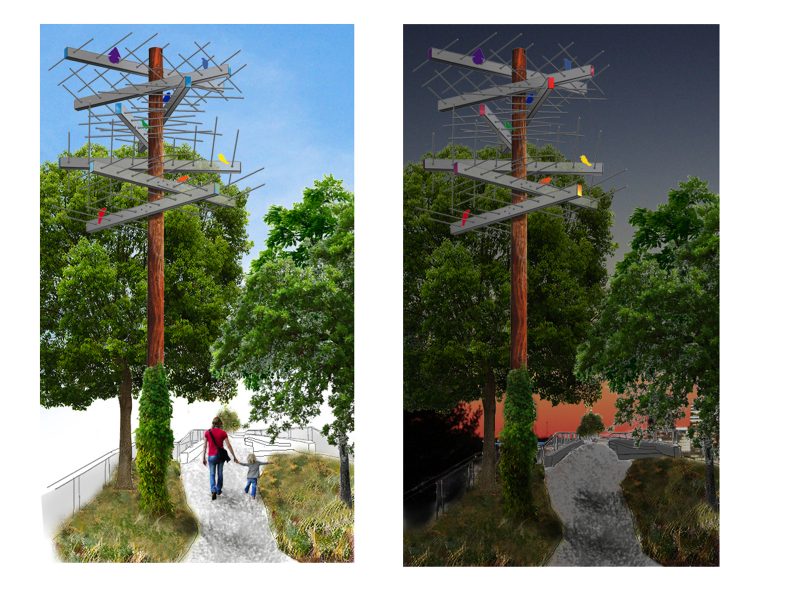
But chaos is precisely the intent of the artists. Their proposal is not public art as icon, as the Commissioners pushed it to be. Theirs is public art as subtle and poetic enhancement to the environment. In Wahl’s presentation, he eagerly described that the “telephone poles could blend into the natural environment,” and even hoped “that vines would group the base, further camouflaging it.” The current rendering even shows the start of this natural takeover.
This is a work that relies on a series of delicate and sophisticated metaphors. The sculptural elements aren’t works of beauty, but neither is our Rail Park. Yes, this park will be beautiful, but more for the metaphor of an abandoned and overgrown rail transformed into a community green space. The landscape architect of Rail Park’s Phase 1, Studio Bryan Haynes, traded manicured beauty for artfully rusting cor-ten steel beams to preserve the site’s legacy. “Dawn Chorus” also works with its Rail Park site, embedded with an ethos of rehabilitation, not reinvention.
Laynie Browne and Brent Wahl were among 68 applicants that responded to the Request for Qualifications issued by the Office of Arts, Culture and the Creative Economy (OACCE) in September 2015. Their proposal was selected as a finalist for this $33,000 opportunity by a panel including representatives from the OACCE, the Friends of the Rail Park, Studio Bryan Haynes, and the Center City District.
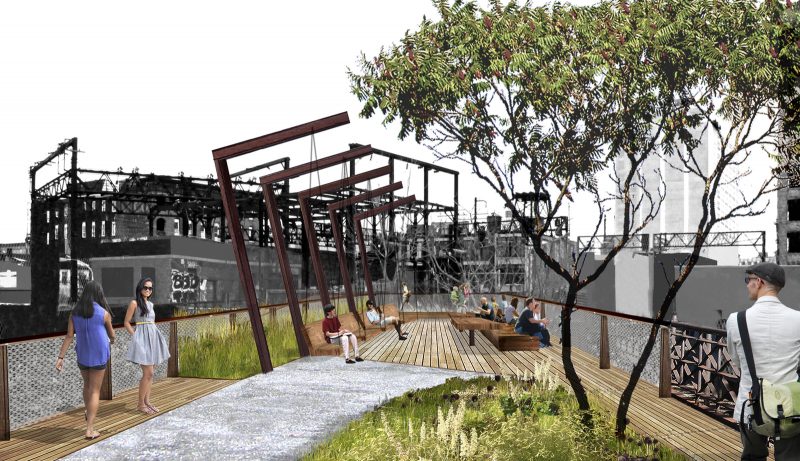
Philadelphia is a city with a One Percent for Art program in its Office of Arts, Culture and the Creative Economy, and another Percent for Art program in the Philadelphia Redevelopment Authority. Wahl and Browne’s proposed piece is under the jurisdiction of OACCE’s program.
In addition to these percent for art programs, the non-profit Association for Public Art advocates for and actively commissions new public art, roughly one new work each year. Across town, the city’s Mural Arts Program (funded partly by the city, and partly by private donations and foundation grants) commissions countless other works in the public sphere.
In a city with so much public art that is iconic, uplifting, and “landmarking,” (Claes Oldenburg’s “Clothespin,” Robert Indiana’s Love statue, Swann Fountain, etc.), new contemporary public artworks no longer need to function as landmarks. A successful public artwork can act as the symbol of our shared values. We would all be poorer if artists, and their interpretations of public space, were forced to favor “landmarking” over quiet reflection. For an artwork so well suited to its site as this proposal by Brent Wahl and Laynie Browne, perhaps we might let this public art hide in plain sight.
Disclaimer: Dave Kyu is currently working on a neighborhood cultural plan of Callowhill/Chinatown North with the Asian Arts Initiative, of which Friends of the Rail Park is a partner.
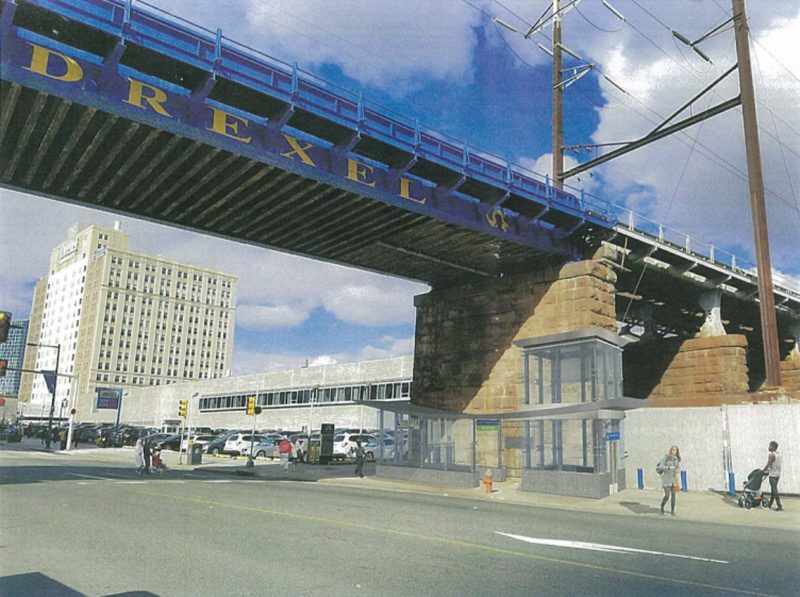
Additional notes
- Septa’s 31th Street Market-Frankford stops are receiving new head houses. The proposal received Conceptual Approval, and when installed the sweeping glass vestibules will provide a new stairwell and elevator entrance to the subway line.
- Although advertising wasn’t proposed at this site, the specter of SEPTA’s plan to fund operations by selling ad space on its properties hung over this decision. Chair Alan Greenberger made clear to SEPTA officials that no modifications, specifically no new ads, could be made to this design without consulting the Art Commission first. With that caveat, this project was granted Conceptual Approval.








